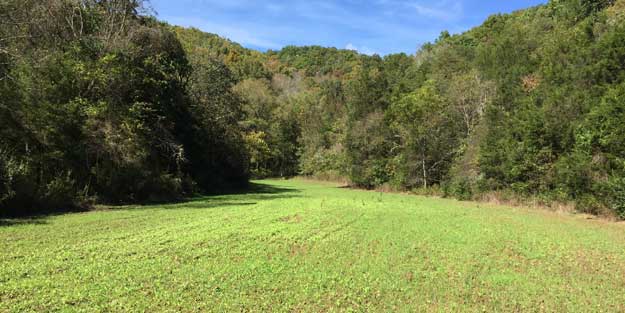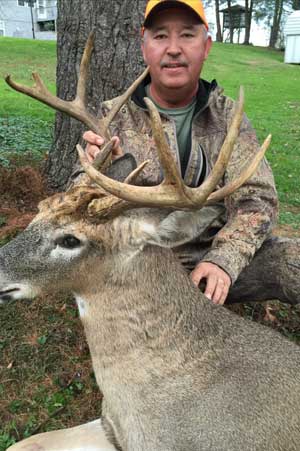Benny Collins | Mossy Oak ProStaff

I first learned the value of planting for wildlife many years ago. I was hunting in Cocke County, Tennessee, on one of my cousin’s farms. My cousin said, “Benny, go right out there to the corner of the tobacco patch. I've got oats planted there, and deer love oats.”
I went to the oat field my cousin told me to hunt, and I walked down the fence line until I arrived at the patch of oats. I could see a deer trail coming off another property and hair on the fence, indicating that the deer had jumped the fence to get to the oats. I saw where the trail led out into the oats right behind the tobacco patch.
Back then, I had an old Baker tree stand, one of the first commercial tree stands ever built. I went up a pine tree the first evening I hunted, and I saw four deer come down the trail, jump the fence and begin to feed on the oats. Remember, that back in those days, deer in most southern states had been almost wiped out during the Great Depression of the 1930s. So, just seeing a deer track was a really big deal. When I had four doe targets out in front of me, I drew my bow and shot the biggest doe in the bunch. Ever since that hunt, I’ve realized that if I can plant some type of crop for deer, I’ll have a much greater opportunity to see and take deer.
In years past, most hunters were at the mercy of the farmers. Some of the farmers either would plant or leave some of their grain crops standing in the fields close to the wood line. The majority of the farmers wouldn’t give up that little extra income that the edges of their properties could provide, so they didn’t plant or leave a portion of their crop for wildlife.
Finally, I told one of my cousins, “I’ll buy wheat, oats, barley or whatever you want to grow for wildlife.”
 Well, since most of my cousins liked to hunt deer and didn’t have to pay for the seed, we struck a bargain. Again, remember, this took place many years ago. As my cousins planted the seeds I’d bought and left more of their different agricultural fields with some of their crops for wildlife, I quickly saw the advantages of planting crops for deer and how that would help deer hunting. I also observed that even if we had a failure of the acorn crop, deer that normally would be feeding on acorns would move out into our plantings and feed on the crops we had left for them. I learned in my early career of deer hunting that if you plant food for wildlife, the deer would show up.
Well, since most of my cousins liked to hunt deer and didn’t have to pay for the seed, we struck a bargain. Again, remember, this took place many years ago. As my cousins planted the seeds I’d bought and left more of their different agricultural fields with some of their crops for wildlife, I quickly saw the advantages of planting crops for deer and how that would help deer hunting. I also observed that even if we had a failure of the acorn crop, deer that normally would be feeding on acorns would move out into our plantings and feed on the crops we had left for them. I learned in my early career of deer hunting that if you plant food for wildlife, the deer would show up.
I live in Kentucky, and I own a 34-acre farm in Virginia. I have a buddy who owns a lot of land, and I'm in charge of all the plowing, discing, spraying and planting of his land and mine. Every year we plant several food plots for wildlife on each of the farms that my buddy owns. Some of the farms are in Kentucky, others are in Virginia and some in Tennessee. From Middleburg, you can get to all three states in about 5 minutes.
We keep our food plots smaller than 20 acres, because a food plot of 20 acres or more usually has to be hunted with a rifle. The people I hunt with on each one of these farms likes to bowhunt as much as I do. We generally plant food plots as big as 1-1/2 acres to as small as a half-acre and even smaller. We have had food plots as big as 12 acres and as small as 100 feet by 100 feet.
We create our food plots, so we can put two tree stands on each one of the food plots. In our section of the country, our prevailing wind in the morning is a northeast wind and a southwest wind in the afternoon. So, by placing our tree stands in those two directions, we can hunt our food plots in the mornings or the afternoons with the prevailing winds in our face. Usually we’ll only have three or four people on each farm who hunt the food plots.
To learn more about GameKeepers and how to increase wildlife on your property, go to http://www.gamekeepersclub.com. If you’re just becoming interested in having more game on your property, and you'd like to have back issues of “GameKeepers Magazine,” you can order back issues from GameKeepers at any time. You also can go to https://www.plantbiologic.com/t-growthemlikethegamekeepers.aspx.






























